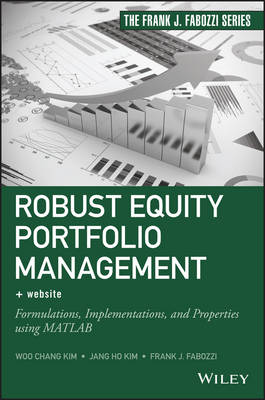Frank J. Fabozzi
52 primary works • 62 total works
Book 176
Probability and Statistics for Finance
by Svetlozar T. Rachev, Markus Hoechstoetter, Frank J. Fabozzi, and Sergio M Focardi
Finance has become increasingly more quantitative, drawing on techniques in probability and statistics that many finance practitioners have not had exposure to before. In order to keep up, you need a firm understanding of this discipline.
Probability and Statistics for Finance addresses this issue by showing you how to apply quantitative methods to portfolios, and in all matter of your practices, in a clear, concise manner. Informative and accessible, this guide starts off with the basics and builds to an intermediate level of mastery.
• Outlines an array of topics in probability and statistics and how to apply them in the world of finance
• Includes detailed discussions of descriptive statistics, basic probability theory, inductive statistics, and multivariate analysis
• Offers real-world illustrations of the issues addressed throughout the text
The authors cover a wide range of topics in this book, which can be used by all finance professionals as well as students aspiring to enter the field of finance.
Book 177
Book 178
Pamela Peterson Drake, PhD, CFA, (Harrisonburg, VA), is the J. Gray Ferguson Professor of Finance and Department Head of Finance and Business Law at James Madison University.
Book 179
Foundations and Applications of the Time Value of Money
by Pamela Peterson Drake and Frank J. Fabozzi
Book 181
Operational Risk
by Anna S. Chernobai, Svetlozar T. Rachev, and Frank J. Fabozzi
Written by the experienced team of Anna Chernobai, Svetlozar Rachev, and Frank Fabozzi, Operational Risk will introduce you to the key concepts associated with this discipline. Filled with in–depth insights, expert advice, and innovative research, this comprehensive guide not only presents you with an abundant amount of information regarding operational risk, but it also walks you through a wide array of examples that will solidify your understanding of the issues discussed.
Topics covered include:
- The main challenges that exist in modeling operational risk.
- The variety of approaches used to model operational losses.
- Value–at–Risk and its role in quantifying and managing operational risk.
- The three pillars of the Basel II Capital Accord.
- And much more.
Book 187
Financial Models with Levy Processes and Volatility Clustering
by Svetlozar T. Rachev, Young Shin Kim, Michele L. Bianchi, and Frank J. Fabozzi
In Financial Models with Lévy Processes and Volatility Clustering, the expert author team provides a framework to model the behavior of stock returns in both a univariate and a multivariate setting, providing you with practical applications to option pricing and portfolio management. They also explain the reasons for working with non-normal distribution in financial modeling and the best methodologies for employing it.
The book's framework includes the basics of probability distributions and explains the alpha-stable distribution and the tempered stable distribution. The authors also explore discrete time option pricing models, beginning with the classical normal model with volatility clustering to more recent models that consider both volatility clustering and heavy tails.
- Reviews the basics of probability distributions
- Analyzes a continuous time option pricing model (the so-called exponential Lévy model)
- Defines a discrete time model with volatility clustering and how to price options using Monte Carlo methods
- Studies two multivariate settings that are suitable to explain joint extreme events
Financial Models with Lévy Processes and Volatility Clustering is a thorough guide to classical probability distribution methods and brand new methodologies for financial modeling.
Book 189
Leveraged Finance
by Stephen J Antczak, Douglas J. Lucas, and Frank J. Fabozzi
Book 192
Book 194
The Handbook of Traditional and Alternative Investment Vehicles
by Mark J. P. Anson, Frank J. Fabozzi, and Frank J. Jones
This practical guide provides a comprehensive overview of traditional and alternative investment vehicles for professional and individual investors hoping to gain a deeper understanding of the benefits and pitfalls of using these products.
In it, expert authors Mark Anson, Frank Fabozzi, and Frank Jones clearly present the major principles and methods of investing and their risks and rewards. Along the way, they focus on providing you with the information needed to successfully invest using a host of different methods depending upon your needs and goals.
- Topics include equities, all types of fixed income securities, investment-oriented insurance products, mutual funds, closed-end funds, investment companies, exchange-traded funds, futures, options, hedge funds, private equity, and real estate
- Written by the expert author team of Mark Anson, Frank Fabozzi, and Frank Jones
- Includes valuable insights for everyone from finance professionals to individual investors
Many finance books offer collections of expertise on one or two areas of finance, but The Handbook of Traditional and Alternative Investment Vehicles brings all of these topics together in one comprehensive volume.
Book 195
Financial Advice and Investment Decisions
by Jarrod W. Wilcox and Frank J. Fabozzi
* A comprehensive guide to properly managing investments with a focus on matching security and growth goals with the needs of the investor * Blends insights gleaned from portfolio management practices used prior to the market mayhem of 2007-2009 with cutting-edge academic and professional investment research * Includes innovative and wide-ranging treatment of subjects such as augmented balance sheets, the efficiency of markets, saving, spending, and investing habits, and dealing with uncertainty * Description of opportunities for improving the investing environment The recent financial crisis has opened our eyes to the need for improving the way we invest. This book will put you in a better position to excel in this new economic environment.
Book 200
Mortgage-Backed Securities
by Frank J. Fabozzi, Anand K Bhattacharya, and William S Berliner
Book 204
Quantitative Equity Investing
by Frank J. Fabozzi, Sergio M Focardi, and Petter N Kolm
A comprehensive look at the tools and techniques used in quantitative equity management
Some books attempt to extend portfolio theory, but the real issue today relates to the practical implementation of the theory introduced by Harry Markowitz and others who followed. The purpose of this book is to close the implementation gap by presenting state-of-the art quantitative techniques and strategies for managing equity portfolios.
Throughout these pages, Frank Fabozzi, Sergio Focardi, and Petter Kolm address the essential elements of this discipline, including financial model building, financial engineering, static and dynamic factor models, asset allocation, portfolio models, transaction costs, trading strategies, and much more. They also provide ample illustrations and thorough discussions of implementation issues facing those in the investment management business and include the necessary background material in probability, statistics, and econometrics to make the book self-contained.
- Written by a solid author team who has extensive financial experience in this area
- Presents state-of-the art quantitative strategies for managing equity portfolios
- Focuses on the implementation of quantitative equity asset management
- Outlines effective analysis, optimization methods, and risk models
In today's financial environment, you have to have the skills to analyze, optimize and manage the risk of your quantitative equity investments. This guide offers you the best information available to achieve this goal.
The Basics of Financial Econometrics
by Frank J. Fabozzi, Sergio M Focardi, Svetlozar T. Rachev, Bala G. Arshanapalli, and Markus Hoechstoetter
As finance and financial products have become more complex, financial econometrics has emerged as a fast-growing field and necessary foundation for anyone involved in quantitative finance. The techniques of financial econometrics facilitate the development and management of new financial instruments by providing models for pricing and risk assessment. In short, financial econometrics is an indispensable component to modern finance.
The Basics of Financial Econometrics covers the commonly used techniques in the field without using unnecessary mathematical/statistical analysis. It focuses on foundational ideas and how they are applied. Topics covered include: regression models, factor analysis, volatility estimations, and time series techniques.
- Covers the basics of financial econometrics—an important topic in quantitative finance
- Contains several chapters on topics typically not covered even in basic books on econometrics such as model selection, model risk, and mitigating model risk
Geared towards both practitioners and finance students who need to understand this dynamic discipline, but may not have advanced mathematical training, this book is a valuable resource on a topic of growing importance.
Robust Portfolio Optimization and Management
by Frank J. Fabozzi, Sergio M Focardi, Petter N Kolm, and Dessislava Pachamanova
I highly recommend this book to finance professionals and students alike." --John M. Mulvey, Professor of Operations Research and Financial Engineering, Princeton University
Mathematical Methods for Finance
by Sergio M Focardi, Frank J. Fabozzi, and Turan G. Bali
With the rapid growth in quantitative finance, practitioners must achieve a high level of proficiency in math and statistics. Mathematical Methods and Statistical Tools for Finance, part of the Frank J. Fabozzi Series, has been created with this in mind. Designed to provide the tools needed to apply finance theory to real world financial markets, this book offers a wealth of insights and guidance in practical applications.
It contains applications that are broader in scope from what is covered in a typical book on mathematical techniques. Most books focus almost exclusively on derivatives pricing, the applications in this book cover not only derivatives and asset pricing but also risk management—including credit risk management—and portfolio management.
- Includes an overview of the essential math and statistical skills required to succeed in quantitative finance
- Offers the basic mathematical concepts that apply to the field of quantitative finance, from sets and distances to functions and variables
- The book also includes information on calculus, matrix algebra, differential equations, stochastic integrals, and much more
- Written by Sergio Focardi, one of the world's leading authors in high-level finance
Drawing on the author's perspectives as a practitioner and academic, each chapter of this book offers a solid foundation in the mathematical tools and techniques need to succeed in today's dynamic world of finance.
Robust Equity Portfolio Management
by Woo Chang Kim, Jang Ho Kim, and Frank J. Fabozzi
Robust Equity Portfolio Management + Website offers the most comprehensive coverage available in this burgeoning field. Beginning with the fundamentals before moving into advanced techniques, this book provides useful coverage for both beginners and advanced readers. MATLAB code is provided to allow readers of all levels to begin implementing robust models immediately, with detailed explanations and applications in the equity market included to help you grasp the real-world use of each technique. The discussion includes the most up-to-date thinking and cutting-edge methods, including a much-needed alternative to the traditional Markowitz mean-variance model. Unparalleled in depth and breadth, this book is an invaluable reference for all risk managers, portfolio managers, and analysts.
Portfolio construction models originating from the standard Markowitz mean-variance model have a high input sensitivity that threatens optimization, spawning a flurry of research into new analytic techniques. This book covers the latest developments along with the basics, to give you a truly comprehensive understanding backed by a robust, practical skill set.
- Get up to speed on the latest developments in portfolio optimization
- Implement robust models using provided MATLAB code
- Learn advanced optimization methods with equity portfolio applications
- Understand the formulations, performances, and properties of robust portfolios
The Markowitz mean-variance model remains the standard framework for portfolio optimization, but the interest in--and need for--an alternative is rapidly increasing. Resolving the sensitivity issue and dramatically reducing portfolio risk is a major focus of today's portfolio manager. Robust Equity Portfolio Management + Website provides a viable alternative framework, and the hard skills to implement any optimization method.
Portfolio Construction and Analytics
by Frank J. Fabozzi and Dessislava A. Pachamanova
Portfolio Construction and Analytics provides an up-to-date understanding of the analytic investment process for students and professionals alike. With complete and detailed coverage of portfolio analytics and modeling methods, this book is unique in its multi-disciplinary approach. Investment analytics involves the input of a variety of areas, and this guide provides the perspective of data management, modeling, software resources, and investment strategy to give you a truly comprehensive understanding of how today's firms approach the process. Real-world examples provide insight into analytics performed with vendor software, and references to analytics performed with open source software will prove useful to both students and practitioners.
Portfolio analytics refers to all of the methods used to screen, model, track, and evaluate investments. Big data, regulatory change, and increasing risk is forcing a need for a more coherent approach to all aspects of investment analytics, and this book provides the strong foundation and critical skills you need.
- Master the fundamental modeling concepts and widely used analytics
- Learn the latest trends in risk metrics, modeling, and investment strategies
- Get up to speed on the vendor and open-source software most commonly used
- Gain a multi-angle perspective on portfolio analytics at today's firms
Identifying investment opportunities, keeping portfolios aligned with investment objectives, and monitoring risk and performance are all major functions of an investment firm that relies heavily on analytics output. This reliance will only increase in the face of market changes and increased regulatory pressure, and practitioners need a deep understanding of the latest methods and models used to build a robust investment strategy. Portfolio Construction and Analytics is an invaluable resource for portfolio management in any capacity.













